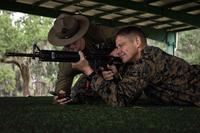
The Army has opened a $1-million engine test facility for its $200-billion Future Combat Systems program amid Congressional concerns that the ambitious modernization program costs too much and fails to improve upon existing weapons.
The test facility at the Tank-Automotive Research and Development Center (TARDEC) in Warren, Michigan, includes several bays where engineers from the Army and from General Dynamics -- one of several major defense firms associated with FCS -- can install prototype hybrid-electric engines and their associated generators and put them through power loads simulating use in combat. Hybrid engines are slated for installation in the FCS manned vehicles, the first of which would enter service around 2014.
Major Scott Tufts from the FCS mobility program office says an engine currently getting a workout at TARDEC will be fitted to a test model of the BAE Systems Non-Line-of-Sight Cannon, the FCS howitzer, in August. A partial howitzer prototype mounted on an improvised, old-fashioned chassis is already undergoing firing tests at Yuma Proving Ground in Arizona.
Before the 5.5-liter, five-cylinder engine can be installed on the howitzer prototype, engineers at TARDEC must map its performance across a wide range of power loads and in extreme environmental conditions. We can take the engine anywhere on the power map. We can do starting and backing up, says John Srodawa, a General Dynamics engineer. Plus TARDECs test bays can be heated to 160 degrees Fahrenheit in order to simulate high noon in the worlds hottest deserts.
The first engine to undergo testing has so far logged around 110 hours in the bay, in bursts no longer than three hours, according to Srodawa. But he says that testing will soon ramp up to full power for up to 10 hours at a time. The goal is to acquire enough data to map the engines efficiency. That, he adds, will help engineers answer the question, How do we optimize the engine and generator so that they give us the best fuel consumption?
Despite testing progress, Congress has questioned FCS schedule and goals. This month the House Armed Services Committee voted to cut $900 million from the programs 2008 budget, saying that war expenses and an Army-wide maintenance backlog were more urgent -- and that FCS duplicates some existing Army capabilities. The proposed cut comes on the heels of the Armys decision last year to defer four of the 18 vehicles and robots planned for FCS in order to save money.
But even if the House cut sticks, FCS would still get nearly $3 billion next year. And Rep. Neil Abercrombie (D-Hawaii) from the House committee says thats plenty for FCS to meet its 2008 goals, including full installation of the first hybrid engine.
-- David Axe







